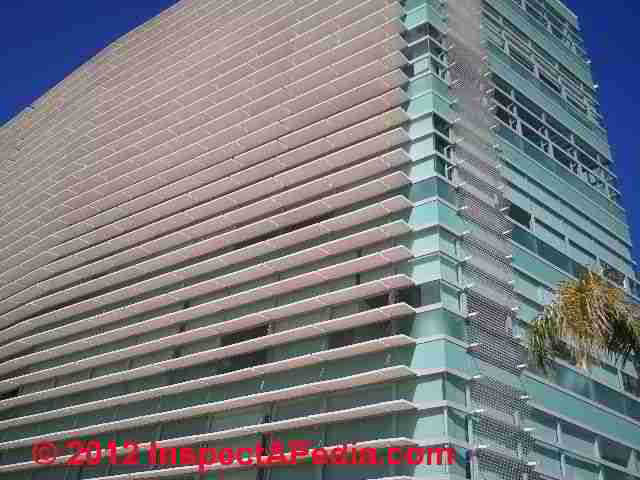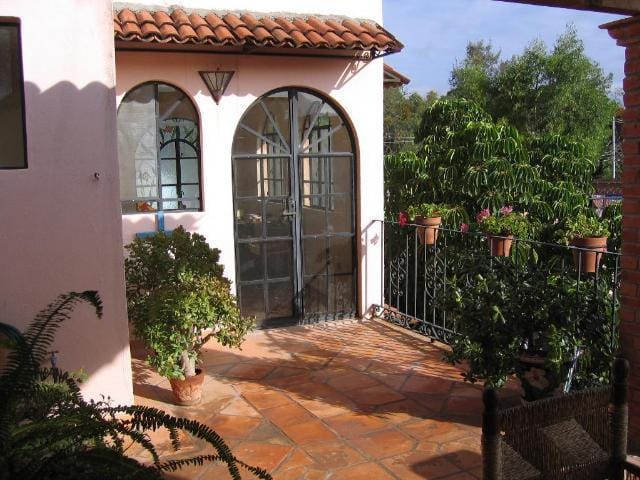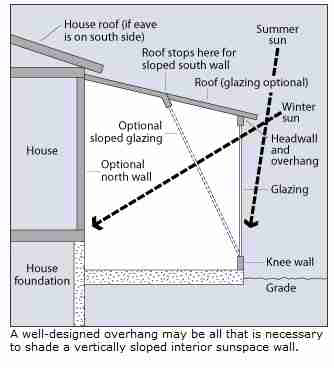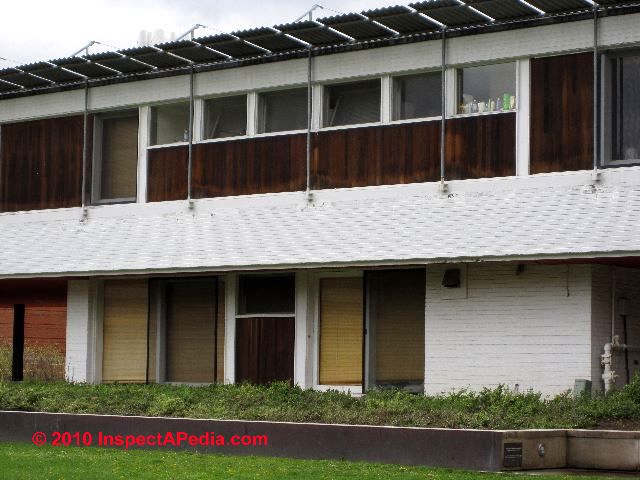 Passive Solar Design Roof Overhang Explanation & Design Details
Passive Solar Design Roof Overhang Explanation & Design Details
- POST a QUESTION or COMMENT about the use of roof overhangs & shading to control heat gain in buildings
Use of roof overhangs & shading to control heat gain in buildings:
This article discusses the use of roof overhangs as a component of passive solar design; we include links to additional passive solar design as well as solar design evaluation questions and answers.
Our page top photo illustrates extensive use of solar shading on a government office building in Queretaro, Mexico.
InspectAPedia tolerates no conflicts of interest. We have no relationship with advertisers, products, or services discussed at this website.
- Daniel Friedman, Publisher/Editor/Author - See WHO ARE WE?
Guide to Passive Solar Home Design: Using Roof Overhangs
 Passive Solar Home Design for Summer Comfort - using shade
Passive Solar Home Design for Summer Comfort - using shade
It makes little sense to save money on winter heating just to spend it on summer cooling. So in most climates, a passive solar home design must provide summer comfort as well.
The solar heat in the summer must be blocked by an overhang or other devices, such as awnings, shutters, and trellises.
Roof Overhangs Control Building Heat Gain & Sunlight
The physical dimensions of an overhang are an important element because overheating will occur unless the overhang provides enough shade.
[The solar overhang shown in our photo (above-left) is located on a home in San Miguel de Allende, Mexico and is discussed in more detail
at PASSIVE SOLAR HEAT PERFORMANCE.
The addition of these small overhangs above windows on the East and West facing sides of this studio made the difference between having a comfortable space and having a space that was just too warm to occupy late in the afternoons.
For a contrasting example, another home in the same area that has no roof overhangs to control solar gain is discussed
at PASSIVE SOLAR HOME, LOW COST. -- DF
Many variables—including latitude, climate, solar radiation transmittance, il luminance levels, and window size and type—need to be considered for properly sizing an overhang in a specific locale. Therefore, it's best to have an experienced solar designer or builder calculate the proper overhang dimensions. For more information, see roof overhangs [below] for shading building elements.
In passive solar home design, exterior roof overhangs provide a practical method for shading building elements such as windows, doors, and walls.
How Roof Overhangs or Other Window Overhangs Work to Control Heat and Solar Gain
Overhangs are most effective for south facing elements (in the northern hemisphere) and at midday. If the building element bears more than about 30° off true south, the effectiveness of an overhang, as with any solar feature, begins to decrease significantly.
Overhangs usually only affect the amount of direct solar radiation that strikes a surface. Diffuse sky and reflected radiation gains are not often directly affected by overhangs.
The higher overhead the sun is, the shorter the shadow a person will cast on the ground. However, the short brim of a baseball cap can create a long shadow across the body of a standing person. The same concept applies in designing overhangs for buildings.
The higher, or more vertical, the arc of the sun, the longer the shadow that the building overhang generates along the face of the wall. Summer shadows extend down walls the furthest, winter shadows the least. Sites closer to the equatorial path of the sun have deeper-extending wall shadows than ones farther from the equator, assuming the same overhang length.
Types of Roof or Window Overhangs for Sunlight & Solar Gain Control
Overhangs may be solid, louvered, vegetation-supporting, or a combination of all of these aspects. Some shutters, eaves, trellises, light shelves, and awnings serve the same purpose as an overhang.
Our photo (left) demonstrates a passive solar overhang in use on the East-facing wall of this building on the Vassar College campus, Poughkeepsie, NY.
Overhangs may also be fixed, operable, and/or removable. Examples include roof eaves, awnings, and Bahama shutters (top-hinged louvered shutters typically propped open with wooden dowels) respectively.
Fixed overhangs offer perceived longevity and low maintenance at the expense of flexibility or the ability to adjust to site-specific factors. Although adjustable devices allow the user to fine tune the amount of shade or direct sunlight, they require more maintenance. Removable fixtures generally provide flexibility and longevity plus some personal involvement with installation and removal.
 Openings, such as windows, do not always require fixed overhangs. A fixed overhang designed for optimal shading on the autumnal equinox (September 21) casts the same shadow on the vernal equinox (March 21).
Openings, such as windows, do not always require fixed overhangs. A fixed overhang designed for optimal shading on the autumnal equinox (September 21) casts the same shadow on the vernal equinox (March 21).
While northern-hemisphere shading may be welcome in September because of the heat, shading in March may be undesirable. Vegetation, on the other hand, can follow the climatic seasons.
Vines that shed their leaves for winter usually leaf out about the time shading is needed. Movable shading devices, while adjustable, often become maintenance problems.
Sizing Roof or Window Overhangs
Unfortunately, there is as yet no universally simple formula for sizing overhangs. While one overhang methodology works well for some locations, it can be completely inappropriate for others.
For example, there are a limited number of overhang-sizing guidelines acceptable for buildings located in southern states, particularly hot-humid climates.
Guidelines acceptable for the high plains of Montana are unlikely to work for a site in Florida.
Due to the varying microclimate conditions encountered across the United States, the methods presented here are general in scope. Anyone seeking a more specialized analysis should seek professional advice from an architect trained in passive solar design.
Every climate requires special design attention. The following general guidelines may be useful in determining a suitable overhang design.
The guidelines are listed by climate type, for solar noon, when the sun reaches its maximum altitude for a given day. Solar noon is very rarely the same as noon in local standard time.
- Cold climates:
above 6,000 heating degree days (HDD)* (at base 65°F [18°C])Locate shadow line at mid-window using the June 21 (summer solstice) sun angle.
- Moderate climates:
below 6,000 heating degree days (HDD)* (at base 65°F [18°C]) and below 2,600 cooling degree days (CDD)* (at base 75°F [22°C])Locate shadow line at window sill using the June 21 (summer solstice) sun angle.
- Hot climates:
above 2,600 cooling degree days (CDD)* (base 75°F [22°C])Locate shadow line at window sill using the March 21 (vernal equinox) sun angle.
*(HDD and CDD data is available from local weather services.)
Roof or Window Solar Gain Control Overhangs and Zoning Ordinances
Overhangs may be inappropriate for sites with restrictive regulatory guidelines. For example, your calculations indicate your house needs a three foot (~1 meter[m]) overhang on the front. The local zoning ordinance restricts eave extension to two feet (0.61 m) beyond the front yard setback.
If your house will be or is located precisely on the setback, you must do one of the following:
- relocate your house at least one foot (0.3 mm) back from the front building setback [OPINION: Surely this is absurd advice, not to mention the decimal point error-DF];
- redesign your building fenestration (windows, doors, grilles, vents, and other openings) [OPINION: surely this is cost prohibitive in retrofit applications -DF];
- redesign your overhang; or
- apply for a variance (an exception to the ordinance) [OPINION: common -DF.].
Passive Solar Design Key Reference Books including Online Texts
The first three passive solar design handbook links below are to free, online documents - in PDF format.
- PASSIVE SOLAR DESIGN HANDBOOK VOLUME I [PDF], the Passive Solar Handbook Introduction to Passive Solar Concepts, in a version used by the U.S. Air Force
- PASSIVE SOLAR DESIGN HANDBOOK VOLUME II [PDF], the Passive Solar Handbook Comprehensive Planning Guide, in a version used by the U.S. Air Force - online version available at this link and from the USAF also at wbdg.org/ccb/AF/AFH/pshbk_v2.pdf [This is a large PDF file that can take a while to load]
- PASSIVE SOLAR HANDBOOK VOLUME III [PDF], the Passive Solar Handbook Programming Guide, in a version used by the U.S. Air Force - online version available at this link and from the USAF also at wbdg.org/ccb/AF/AFH/pshbk_v3.pdf
- The Passive Solar Design and Construction Handbook, Steven Winter Associates (Author), Michael J. Crosbie (Editor), Wiley & Sons, ISBN 978-047118382 or 0471183083 the The Passive Solar Design and Construction Handbook, Steven Winter Associates (Author), Michael J. Crosbie (Editor), Wiley & Sons, ISBN 978-047118382 or 0471183083
- "PASSIVE SOLAR HOME DESIGN [PDF] ", U.S. Department of Energy, describes using a home's windows, walls, a nd floors to collect and store solar energy for winter heating and also rejecting solar heat in warm weather.
Here we include solar energy, solar heating, solar hot water, and related building energy efficiency improvement articles reprinted/adapted/excerpted with permission from Solar Age Magazine - editor Steven Bliss.
...
Continue reading at PASSIVE SOLAR DESIGN KEY ELEMENTS or select a topic from the closely-related articles below, or see the complete ARTICLE INDEX.
Or see these
Recommended Articles
- GREENHOUSE / SUNSPACE GLARE - use of shades and louvers for sunlight glare control in buildings
- PASSIVE SOLAR DESIGN HANDBOOK - PDF
- PASSIVE SOLAR DESIGN KEY ELEMENTS
- PASSIVE SOLAR DESIGN METHOD
- PASSIVE SOLAR ENERGY MONITORING
- PASSIVE SOLAR FLOOR TILES, PHASE CHANGE
- PASSIVE SOLAR HEAT PERFORMANCE
- PASSIVE SOLAR HOME, LOW COST
- PASSIVE SOLAR PERFORMANCE PROBE
- PASSIVE SOLAR Roof & Window OVERHANGS
- PATIO AWNING INSTALLATION
- SOLAR ENERGY SYSTEMS - home
- SOLAR SHADES & SUNSCREENS
- SUNGAIN, FILMS, LOW-E GLASS
- WINDOW / DOOR ENERGY EFFICIENT, DOE
- WINDOW GLAZING BASED on CLIMATE
- WINDOWS & DOORS - home
Suggested citation for this web page
PASSIVE SOLAR Roof & Window OVERHANGS at InspectApedia.com - online encyclopedia of building & environmental inspection, testing, diagnosis, repair, & problem prevention advice.
Or see this
INDEX to RELATED ARTICLES: ARTICLE INDEX to SOLAR ENERGY
Or use the SEARCH BOX found below to Ask a Question or Search InspectApedia
Ask a Question or Search InspectApedia
Questions & answers or comments about the use of roof overhangs & shading to control heat gain in buildings.
Try the search box just below, or if you prefer, post a question or comment in the Comments box below and we will respond promptly.
Search the InspectApedia website
Note: appearance of your Comment below may be delayed: if your comment contains an image, photograph, web link, or text that looks to the software as if it might be a web link, your posting will appear after it has been approved by a moderator. Apologies for the delay.
Only one image can be added per comment but you can post as many comments, and therefore images, as you like.
You will not receive a notification when a response to your question has been posted.
Please bookmark this page to make it easy for you to check back for our response.
IF above you see "Comment Form is loading comments..." then COMMENT BOX - countable.ca / bawkbox.com IS NOT WORKING.
In any case you are welcome to send an email directly to us at InspectApedia.com at editor@inspectApedia.com
We'll reply to you directly. Please help us help you by noting, in your email, the URL of the InspectApedia page where you wanted to comment.
Citations & References
In addition to any citations in the article above, a full list is available on request.
- [1] Passive Solar Home Design - U.S. DOE Suggestions energysavers.gov/your_home/designing_remodeling/index.cfm/mytopic=10250
- [2] How a Passive Solar Home Works - U.S. DOE original source: energysavers.gov/your_home/designing_remodeling/index.cfm/mytopic=10260
- [3] Direct Solar Gain - U.S. DOE - original source: energysavers.gov/your_home/designing_remodeling/index.cfm/mytopic=10290
- [4] Indirect Solar Gain - U.S. DOE - original source: energysavers.gov/your_home/designing_remodeling/index.cfm/mytopic=10300
- [5] Isolated Solar Gain - U.S. DOE - original source: http://www.energysavers.gov/your_home/designing_remodeling/index.cfm/mytopic=10310
- [6] Passive Solar Window Design - U.S. DOE
- energysavers.gov/your_home/windows_doors_skylights/index.cfm/mytopic=13360
- PASSIVE SOLAR DESIGN HANDBOOK VOLUME I [PDF], the Passive Solar Handbook Introduction to Passive Solar Concepts, in a version used by the U.S. Air Force
- PASSIVE SOLAR DESIGN HANDBOOK VOLUME II [PDF], the Passive Solar Handbook Comprehensive Planning Guide, in a version used by the U.S. Air Force - online version available at this link and from the USAF also at wbdg.org/ccb/AF/AFH/pshbk_v2.pdf [This is a large PDF file that can take a while to load]
- PASSIVE SOLAR HANDBOOK VOLUME III [PDF], the Passive Solar Handbook Programming Guide, in a version used by the U.S. Air Force - online version available at this link and from the USAF also at wbdg.org/ccb/AF/AFH/pshbk_v3.pdf
- The Passive Solar Design and Construction Handbook, Steven Winter Associates (Author), Michael J. Crosbie (Editor), Wiley & Sons, ISBN 978-047118382 or 0471183083
- "PASSIVE SOLAR HOME DESIGN [PDF] ", U.S. Department of Energy, describes using a home's windows, walls, and floors to collect and store solar energy for winter heating and also rejecting solar heat in warm weather.
- In addition to citations & references found in this article, see the research citations given at the end of the related articles found at our suggested
CONTINUE READING or RECOMMENDED ARTICLES.
- Carson, Dunlop & Associates Ltd., 120 Carlton Street Suite 407, Toronto ON M5A 4K2. Tel: (416) 964-9415 1-800-268-7070 Email: info@carsondunlop.com. Alan Carson is a past president of ASHI, the American Society of Home Inspectors.
Thanks to Alan Carson and Bob Dunlop, for permission for InspectAPedia to use text excerpts from The HOME REFERENCE BOOK - the Encyclopedia of Homes and to use illustrations from The ILLUSTRATED HOME .
Carson Dunlop Associates provides extensive home inspection education and report writing material. In gratitude we provide links to tsome Carson Dunlop Associates products and services.


